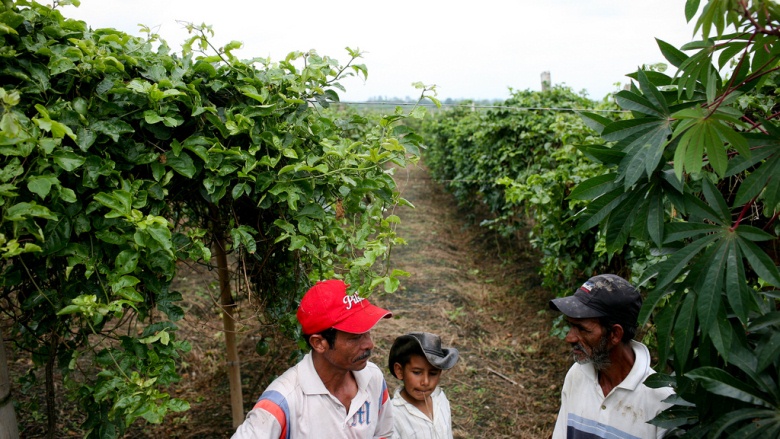Challenge
Similar to other developing countries, the majority of the rural households served by the Project engaged in smallholder agriculture characterized by low productivity, asymmetric information in prices and selling opportunities, and limited market access. Many of these households sold their commodities in markets that were less demanding but also less rewarding, such as village open-air markets. Others sold through intermediaries, due to the small scale of their production, the high transaction costs involved in reaching more distant markets, and their inability to comply with the stringent requirements relating to volume, quality, and timely delivery demanded by modern agricultural value chains. The multiple challenges faced by smallholder producers in Colombia posed major obstacles that prevented them from integrating into rapidly evolving national and international markets, which contributed to sluggish growth and lingering poverty in the rural sector.
Solution
In an effort to support Colombia’s smallholder producers to build entrepreneurship and compete more effectively, the Rural Productive Partnerships Project has been addressing the above-mentioned challenges by establishing, strengthening, and promoting productive alliances between rural producer organizations and private agribusinesses. Launched in 2002, the first phase of the Project introduced a decentralized, demand-driven competitive bidding process for productive partnership proposals along with a transparent, independent evaluation procedure, on which today’s Project continues to build. By providing the resulting selected partnerships with investment grants, technical assistance, and business development training, the Project aims to ensure that these partnerships not only benefit from increased production, sales, and productivity, but also demonstrate high survival rates. Another objective of the Project is to address inequality by reaching different categories of producers, including vulnerable groups such as women, indigenous people, and Afro-Colombians.
Results
The results achieved by the Rural Productive Partnerships Project have been well documented and can be accessed (with authorization) through a modern on-line monitoring and evaluation system operated by Colombia’s Ministry of Agriculture and Rural Development (MADR). Highlights include:
- More than 820 successful productive partnerships benefiting more than 55,000 households were established by the Project between 2002 and 2014 (727 partnerships and more than 44,500 households during the second phase alone, between 2007 and 2014)
- Of the productive partnerships established during the second phase, 72% of participating producer organizations remained linked to their business partners 24 months after Project support ended
- The Project has been successful in reaching vulnerable households headed by single women, as well as households comprising indigenous peoples and Afro-Colombians. More than 9,900 female-headed households have been assisted during the second phase, exceeding the end-of-project target of 2,550 households by more than three-fold. In addition, more than 9.250 indigenous and Afro-Colombian households have been assisted, exceeding the end-of-project target of 1,275 by more than seven-fold.
Bank Group Contribution
The cost of the first phase of the Project (2002-2007; P041642), equivalent to US$ 32 million, was supported entirely by IBRD. The cost of the second phase (2008-2015; P104567), equivalent to US$ 122.4 million, was supported by IBRD in the amount of US$ 30 million, with the balance being provided by other partners including Project beneficiaries.
Partners
The Project was implemented by MADR, with assistance from a decentralized network of regional and local management organizations. A distinguishing feature of the Project is its ability to leverage funding from the public and private sectors. For example during the second phase, of the total Project cost of US$ 122.4 million, US$ 43 million have been contributed by the beneficiary producer organizations themselves, US$ 27.1 million by local governments, US$ 12.4 million by the national government, and US$ 9.9 million agribusiness partners.
Moving Forward
The second phase of the Project ended in June 2015. Nearly all end-of-project targets have been achieved or surpassed. The Government of Colombia is currently making the necessary policy, fiduciary, and operational transition arrangements needed to institutionalize the Rural Productive Partnerships Program within MADR. Due to is documented successes in Colombia, different configurations of the Rural Productive Partnerships approach has been replicated under IBRD-financed projects in eight additional countries throughout Latin America, as well as in several countries in Sub-Saharan Africa and Asia.
Beneficiaries
The impact of the Rural Productive Partnerships Project on the lives of its beneficiaries has been amply documented. A wealth of evidence is presented in the Project briefs and multimedia links listed below. In a typical example, Natan Nieto from the specialty coffee producer organization Asodesarrollo in Huila testifies, “Being associated [with the partnership] enables us to access economic resources and technical assistance.” He confirms that the Rural Productive Partnership Project has helped to “improve the life of my family and protect the environment, increasing my income while avoiding pollution.”
Interviews with a number of Project beneficiaries detailing the socio-economic impact of the Project are available here.
